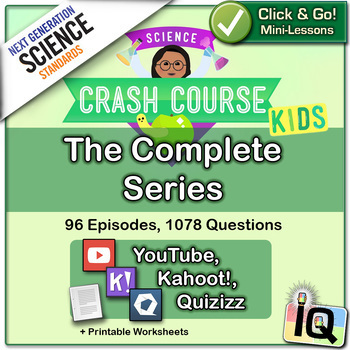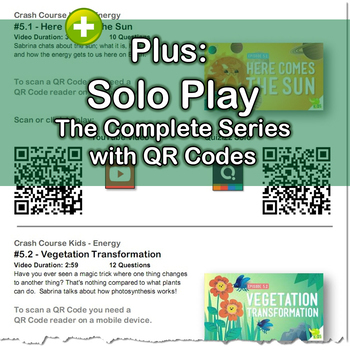Crash Course Kids, Science - Complete Series, Bundle | Digital & Printable
- Zip
- Internet Activities
What educators are saying
Products in this Bundle (10)
showing 1-5 of 10 products
Bonus
Description
Learn about Earth’s Systems, Ecosystems, Forces, Matter, and more!
Point and Click for instant Science Mini-Lessons with Game-Based Assessment using Quizizz and Kahoot!
• This ZIP file contains all nine of my Crash Course Kids Science IQ products, previously published individually, PLUS a compiled PDF with all episodes in chronological order (the order in which they were published on YouTube), PLUS "Solo Mode" QR Codes and links for digital sharing or classroom stations.
• Each PDF document includes organized hyperlinks to educational video content and digital interactive quizzes. Optional printable worksheets are included.
• For each YouTube episode, the quiz is available using two separate platforms: Kahoot and Quizizz. Every multiple-choice question includes a related screenshot from the video (images used with permission).
• Students can use any internet-connected device, working individually or in groups, to input their responses.
The Crash Course videos and Interactive Quizzes in this series are aligned with the Grade 5 Performance Expectations and Disciplinary Core Ideas of the Next Generation Science Standards*.
Included Interactive Quizzes:
Crash Course Kids, Earth and Human Activity
Crash Course Kids, Earth’s Place in the Universe
Crash Course Kids, Earth’s Systems
Crash Course Kids, Engineering Design
Crash Course Kids, Forces and Interactions
Crash Course Kids, From Molecules to Organisms
Crash Course Kids, Matter and Its Interactions
PLUS: Print and Play, or go Paperless to have your students play "Solo" games anywhere, anytime!
Crash Course Kids, Science - Solo Play with QR Codes
BONUS FILE: A compiled PDF with all episodes in chronological order (by YouTube publication date)
***************************************************************************
How to Use the Interactive Quizzes:
Rich Colosi has created introductory videos on both the Kahoot and Quizizz platforms:
Kahoot! For Teachers - Rich Colosi Media on YouTube
Quizizz For Teachers - Rich Colosi Media on YouTube
***************************************************************************
Did you know ...?
• Each time you give feedback on a product, TPT gives you feedback credits that you use to lower the cost of your future purchases. Feedback to TpT Sellers, just like feedback to students, is a valuable tool to aid the improvement of future products. Go to your "My Purchases" page to view past downloads, and provide a rating and comment.
• You can be the first to know about new discounts, freebies, and product launches. Look for the green star next to the TpT store logo and click it to become a follower and receive email updates about the store.
***************************************************************************
* Next Generation Science Standards (“NGSS”) is a registered trademark of Achieve. Neither Achieve nor the lead states and partners that developed the Next Generation Science Standards were involved in the production of this product, and do not endorse it.





